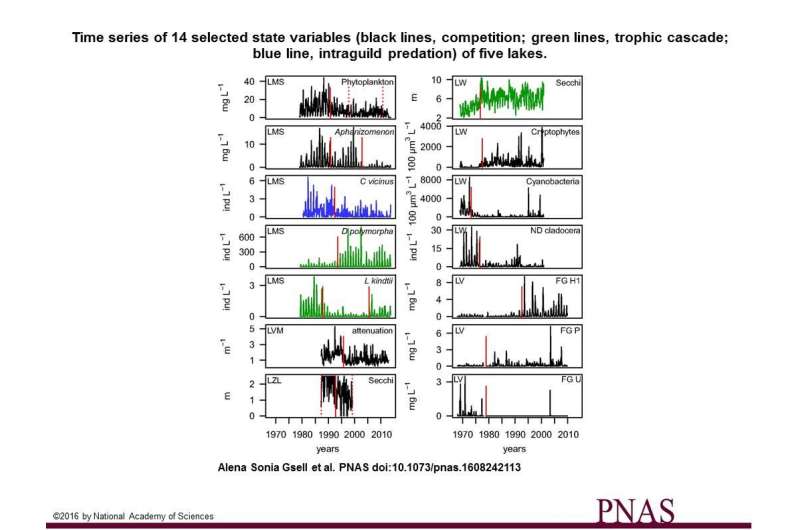Testing early warning signals for crises, in lakes

Wouldn't it be great if we could tell the state of an ecosystem or the like - whether it's healthy or heading for a crisis - by keeping track of just a few key signals? Thanks to the theory of 'tipping points', that's not unthinkable. Now a team of researchers led by Alena Gsell of the Netherlands Institute of Ecology (NIOO-KNAW) has tested early warning signals: in lakes. In the Early Edition of PNAS online, they conclude that predicting works but not in all cases yet.
The term 'tipping point' has become popular to describe sudden and fundamental changes that take place even though exterior conditions haven't changed as radically.
Think of a financial crisis. Think of a wall that will fall down - like the Berlin Wall - or one that will end up being built somewhere else just as suddenly. And what's true for human society is also true for ecosystems: in shallow lakes, clear, limpid water may suddenly turn into smelly green soup.
Once such a 'regime shift' has occurred, it's difficult or even impossible to get things back to the way they were. But that doesn't mean there are no alarm signals. There is in fact a whole range of statistical indicators that have been proposed as possible early warnings.
An international team led by NIOO-researcher Alena Gsell - formerly of the Leibniz Institute of Freshwater Ecology and Inland Fisheries in Berlin - has now for the first time tested the potential of four of these indicators to be applied to a wide range of lakes.
"We've looked at five lakes for which long-term monitoring data (16-34 years) is available", explains Alena Gsell. One of them is the Veluwemeer in the Netherlands, another Lake Washington in the United States.
The good news is that in some cases, early-warning indicators were indeed detected up to several years ahead of the moment when a 'regime shift' would take place. "That leaves some time for water managers to step in and take appropriate measures."
These indicators show that the resilience of lake ecosystems becomes less ahead of a regime shift.
"It's something you can observe if you know an ecosystem well", says Gsell. Perturbations become bigger: water turns turbid temporarily, smaller zooplankton species are favoured and edible green algae lose ground to the less tasty bluegreens.
But on the whole, the team's tests produced many negative results as well. According to Gsell, this mixed outcome shows that the early warning indicators do hold promise as a method, but are not yet as suitable for general application as had been hoped by many.
For the early alarm signals to be more effective, argue the researchers, collecting long term data - an essential "window into the past" - isn't the only thing that's important. The methods for mining the data also need to become more advanced. More frequent data collection would help: per day or even hour, instead of per week or less.
"If you look at the current state of the environment, investing in the adaptation of indicator methods would definitely be an effort well spent."
More information: Alena Sonia Gsell et al, Evaluating early-warning indicators of critical transitions in natural aquatic ecosystems, Proceedings of the National Academy of Sciences (2016). DOI: 10.1073/pnas.1608242113
Journal information: Proceedings of the National Academy of Sciences
Provided by Netherlands Institute of Ecology

















